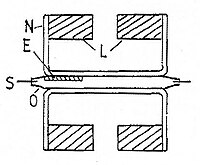Evans balance

Have you ever ridden a see-saw or teeter-totter before? It's a long board that gets balanced in the middle by two people sitting on either end. If one person is heavier than the other, then the see-saw will tilt towards the heavier person.
Evans balance is a bit like a see-saw, but it's used to measure the weight of tiny particles, like atoms or molecules. Instead of people, there are two plates that are balanced in the middle. The top plate is where the tiny particle is placed and the bottom plate is more massive.
When the tiny particle is placed on top of the bottom plate, it will tilt to one side since the particle is lighter than the bottom plate. But, as more and more particles are added to the top plate, it will begin to tilt back towards the center. This is because the added weight of the particles counteracts the weight of the bottom plate.
Scientists use this balance to determine the weight of very small particles. By measuring the angle of the tilt, they can calculate the amount of weight that was added to the top plate. This information helps them to understand the properties of particles and how they interact with other things.
Evans balance is a bit like a see-saw, but it's used to measure the weight of tiny particles, like atoms or molecules. Instead of people, there are two plates that are balanced in the middle. The top plate is where the tiny particle is placed and the bottom plate is more massive.
When the tiny particle is placed on top of the bottom plate, it will tilt to one side since the particle is lighter than the bottom plate. But, as more and more particles are added to the top plate, it will begin to tilt back towards the center. This is because the added weight of the particles counteracts the weight of the bottom plate.
Scientists use this balance to determine the weight of very small particles. By measuring the angle of the tilt, they can calculate the amount of weight that was added to the top plate. This information helps them to understand the properties of particles and how they interact with other things.
